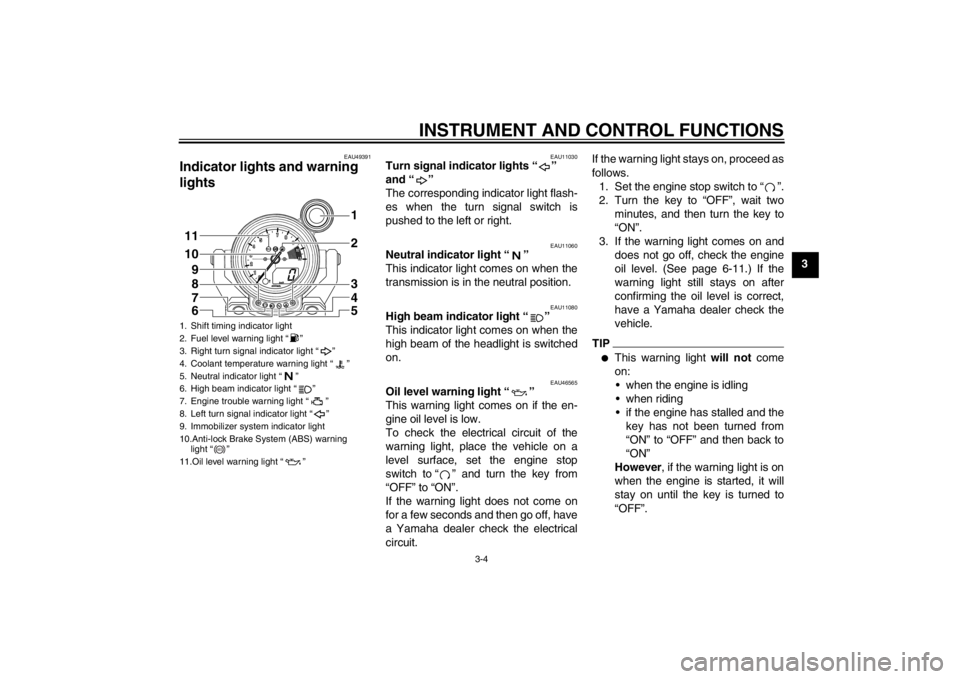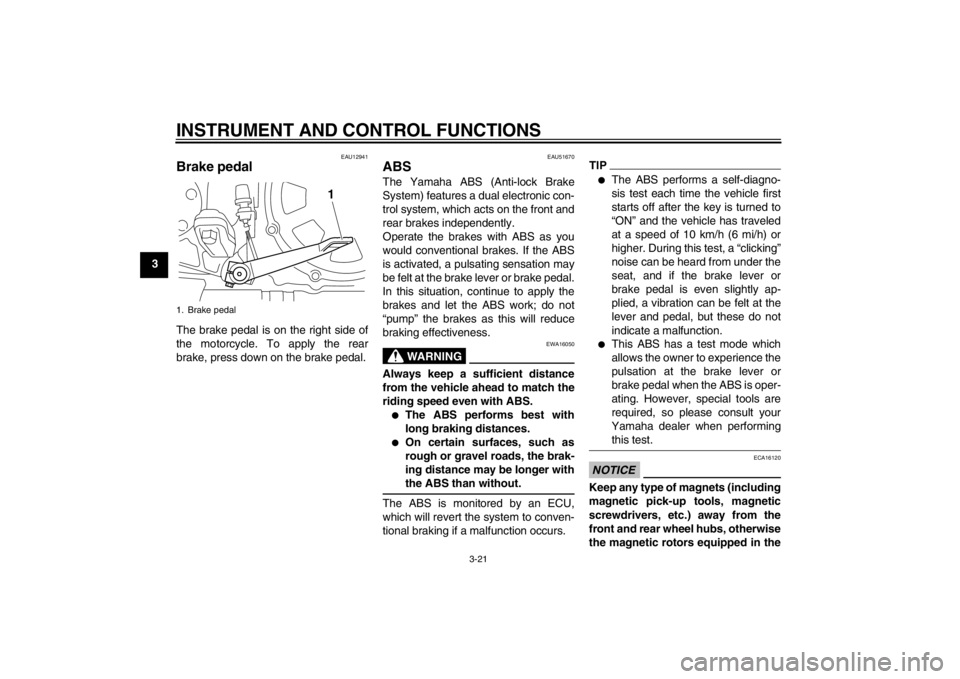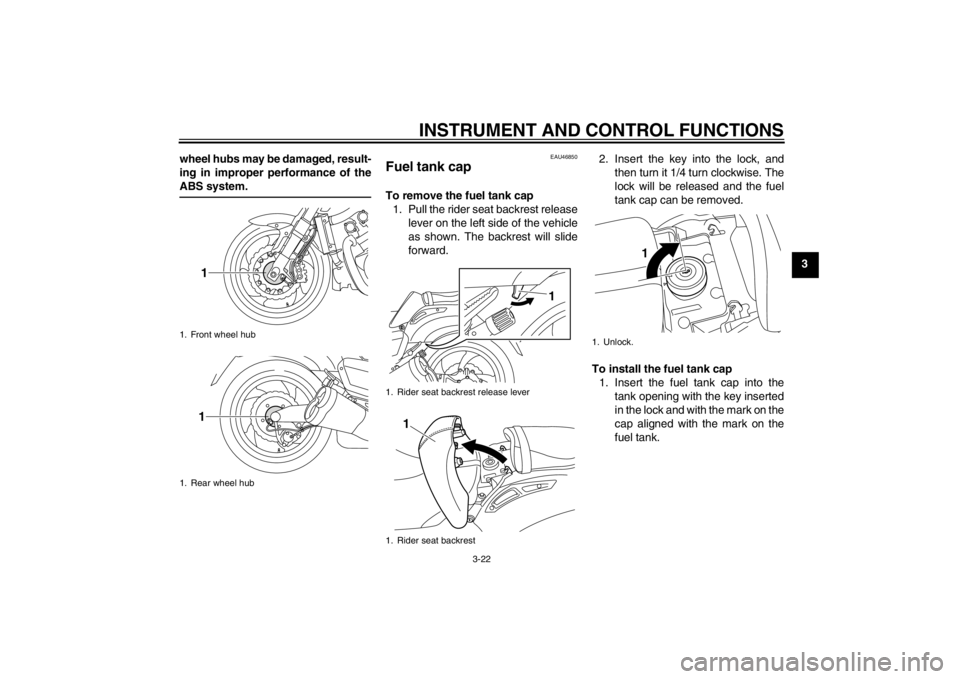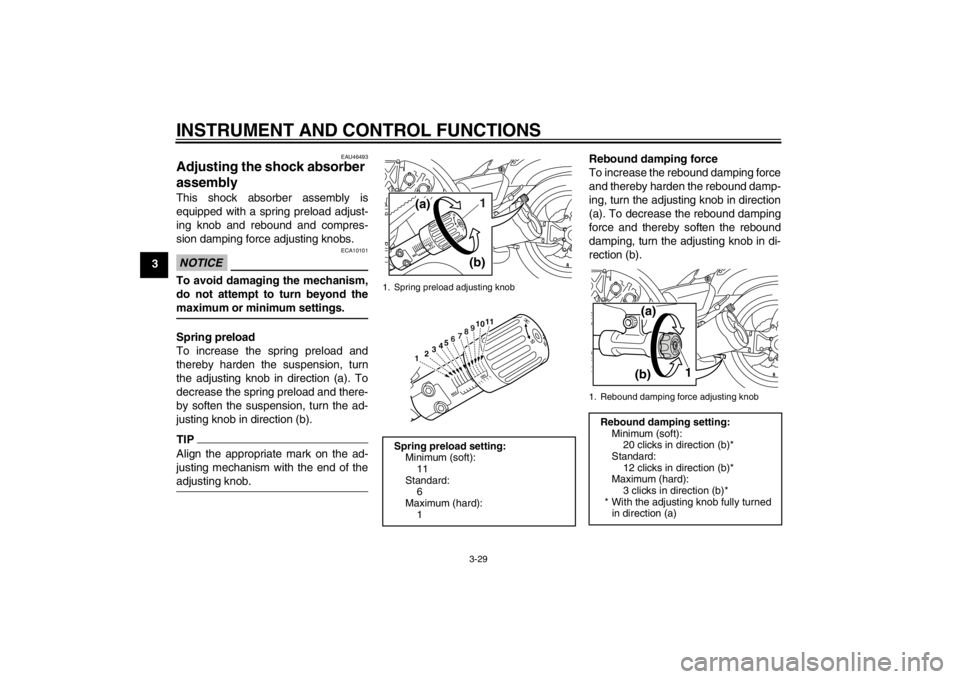ABS YAMAHA VMAX 2012 Owners Manual
[x] Cancel search | Manufacturer: YAMAHA, Model Year: 2012, Model line: VMAX, Model: YAMAHA VMAX 2012Pages: 110, PDF Size: 3.09 MB
Page 6 of 110

TABLE OF CONTENTSSAFETY INFORMATION ..................1-1
DESCRIPTION ..................................2-1
Left view ..........................................2-1
Right view ........................................2-2
Controls and instruments.................2-3
INSTRUMENT AND CONTROL
FUNCTIONS .......................................3-1
Immobilizer system .........................3-1
Main switch/steering lock ................3-2
Indicator lights and warning lights ..............................3-4
Speedometer unit ...........................3-7
Multi-function display ......................3-8
Anti-theft alarm (optional) .............3-17
Handlebar switches ......................3-18
Clutch lever ...................................3-19
Shift pedal .....................................3-20
Brake lever ...................................3-20
Brake pedal ..................................3-21
ABS ..............................................3-21
Fuel tank cap ................................3-22
Fuel ...............................................3-23
Fuel tank breather hose and overflow hose ............................3-24
Catalytic converters ......................3-25
Seats ............................................3-25
Adjusting the front fork ..................3-27
Adjusting the shock absorber assembly ...................................3-29 Luggage strap holders ................. 3-31
EXUP system ............................... 3-31
Sidestand ..................................... 3-31
Ignition circuit cut-off system ........ 3-32
FOR YOUR SAFETY –
PRE-OPERATION CHECKS ............. 4-1
OPERATION AND IMPORTANT
RIDING POINTS ................................. 5-1
Starting the engine ......................... 5-1
Shifting ........................................... 5-2
Tips for reducing fuel consumption ............................... 5-3
Engine break-in .............................. 5-3
Parking ........................................... 5-4
PERIODIC MAINTENANCE AND
ADJUSTMENT ................................... 6-1
Owner’s tool kit ............................... 6-2
Periodic maintenance chart for
the emission control system ....... 6-3
General maintenance and
lubrication chart .......................... 6-4
Removing and installing the cowling and panels ............... 6-8
Checking the spark plugs ............. 6-10
Engine oil and oil filter cartridge ... 6-11
Final gear oil ................................. 6-14
Coolant ......................................... 6-16
Air filter element ........................... 6-19 Checking the engine idling
speed ........................................ 6-19
Checking the throttle grip free play ........................................... 6-20
Valve clearance ........................... 6-20
Tires ............................................. 6-20
Cast wheels ................................. 6-23
Clutch lever .................................. 6-23
Checking the brake lever free
play ........................................... 6-23
Brake light switches ..................... 6-24
Checking the front and
rear brake pads ........................ 6-24
Checking the brake fluid level ...... 6-25
Changing the brake and
clutch fluids ............................... 6-26
Checking and lubricating
the cables ................................. 6-27
Checking and lubricating the throttle grip and cable ......... 6-27
Checking and lubricating the brake and shift pedals ........ 6-27
Checking and lubricating
the brake and clutch levers ...... 6-28
Checking and lubricating the sidestand ............................ 6-29
Lubricating the swingarm pivots ........................................ 6-29
Checking the front fork ................. 6-29
Checking the steering .................. 6-30
Checking the wheel bearings ....... 6-30U2S3E3E0.book Page 1 Monday, September 19, 2011 8:42 AM
Page 13 of 110

DESCRIPTION
2-1
2
EAU10410
Left view
1
4
56
7
8
11
9
10
12
13
14
15
2316
1. Headlight (page 6-35)
2. Front fork spring preload adjusting bolt (page 3-27)
3. Front fork rebound damping force adjusting knob (page 3-27)
4. Battery (page 6-31)
5. Owner’s tool kit (page 6-2)
6. Fuel tank cap (page 3-22)
7. Shock absorber assembly spri
ng preload adjusting knob (page 3-29)
8. Luggage strap holder (page 3-31) 9. Final gear oil check bolt (page 6-14)
10.Final gear oil drain bolt (page 6-14)
11.Shock absorber assembly rebou
nd damping force adjusting knob
(page 3-29)
12.Sidestand (page 3-31)
13.Shift pedal (page 3-20)
14.Engine oil drain bolt (page 6-11)
15.Engine oil filter cartridge (page 6-11)
16.Front fork compression damping force adjusting screw (page 3-27)
U2S3E3E0.book Page 1 Monday, September 19, 2011 8:42 AM
Page 14 of 110

DESCRIPTION
2-2
2
EAU10420
Right view
12 4 67
5
3
9
11
8
10
1. Passenger seat (page 3-25)
2. Rear brake fluid reservoir (page 6-25)
3. Luggage strap holder (page 3-31)
4. Rider seat (page 3-25)
5. Fuse box 1 (page 6-33)
6. Radiator cap (page 6-16)
7. Coolant reservoir (page 6-16)
8. Engine oil level check window (page 6-11) 9. Brake pedal (page 3-21)
10.Fuse box 2 (page 6-33)
11.Shock absorber assembly compression damping force adjusting knob
(page 3-29)U2S3E3E0.book Page 2 Monday, September 19, 2011 8:42 AM
Page 19 of 110

INSTRUMENT AND CONTROL FUNCTIONS
3-4
3
EAU49391
Indicator lights and warning
lights
EAU11030
Turn signal indicator lights “ ”
and “ ”
The corresponding indicator light flash-
es when the turn signal switch is
pushed to the left or right.
EAU11060
Neutral indicator light “ ”
This indicator light comes on when the
transmission is in the neutral position.
EAU11080
High beam indicator light “ ”
This indicator light comes on when the
high beam of the headlight is switched
on.
EAU46565
Oil level warning light “ ”
This warning light comes on if the en-
gine oil level is low.
To check the electrical circuit of the
warning light, place the vehicle on a
level surface, set the engine stop
switch to “ ” and turn the key from
“OFF” to “ON”.
If the warning light does not come on
for a few seconds and then go off, have
a Yamaha dealer check the electrical
circuit.If the warning light stays on, proceed as
follows.
1. Set the engine stop switch to “ ”.
2. Turn the key to “OFF”, wait two minutes, and then turn the key to
“ON”.
3. If the warning light comes on and does not go off, check the engine
oil level. (See page 6-11.) If the
warning light still stays on after
confirming the oil level is correct,
have a Yamaha dealer check the
vehicle.
TIP●
This warning light will not come
on: when the engine is idling
when riding
if the engine has stalled and the key has not been turned from
“ON” to “OFF” and then back to
“ON”
However , if the warning light is on
when the engine is started, it will
stay on until the key is turned to
“OFF”.
1. Shift timing indicator light
2. Fuel level warning light “ ”
3. Right turn signal indicator light “ ”
4. Coolant temperature warning light “ ”
5. Neutral indicator light “ ”
6. High beam indicator light “ ”
7. Engine trouble warning light “ ”
8. Left turn signal indicator light “ ”
9. Immobilizer system indicator light
10.Anti-lock Brake System (ABS) warning light “ ”
11.Oil level warning light “ ”11
10 2
1
9
3
4
5
8
7
6
ABS
U2S3E3E0.book Page 4 Monday, September 19, 2011 8:42 AM
Page 21 of 110

INSTRUMENT AND CONTROL FUNCTIONS
3-6
3
If the warning light does not come on
initially when the key is turned to “ON”,
or if the warning light remains on, have
a Yamaha dealer check the electrical
circuit.
EAU51661
ABS warning light “ ”
In normal operation, the ABS warning
light comes on when the key is turned
to “ON”, and goes off after traveling at a
speed of 10 km/h (6 mi/h) or higher.
If the ABS warning light:●
does not come on when the key is
turned to “ON”
●
comes on or flashes while riding
●
does not go off after traveling at a
speed of 10 km/h (6 mi/h) or higher
The ABS may not work correctly. If any
of the above occurs, have a Yamaha
dealer check the system as soon as
possible. (See page 3-21 for an expla-
nation of the ABS.)WARNING
EWA16040
If the ABS warning light does not go
off after traveling at a speed of 10
km/h (6 mi/h) or higher, or if the
warning light comes on or flashes while riding, the brake system re-
verts to conventional braking. If ei-
ther of the above occurs, or if the
warning light does not come on at
all, use extra caution to avoid possi-
ble wheel lock during emergency
braking. Have a Yamaha dealer
check the brake system and electri-
cal circuits as soon as possible.
TIPIf the start switch is pushed while the
engine is running, the ABS warning
light will come on, but this is not a mal-
function.
EAU48520
Shift timing indicator light
This indicator light can be set to come
on and go off at the desired engine
speeds and is used to inform the rider
when it is time to shift to the next higher
gear.
The electrical circuit of the indicator
light can be checked by turning the key
to “ON”. The indicator light should
come on for a few seconds, and then
go off.
If the indicator light does not come on
initially when the key is turned to “ON”,
or if the indicator light remains on, have
a Yamaha dealer check the electrical
circuit. (See page 3-10 for a detailed
explanation of the function of this indi-
cator light and on how to set it.)
EAU38624
Immobilizer system indicator light
The electrical circuit of the indicator
light can be checked by turning the key
to “ON”. The indicator light should
come on for a few seconds, and then
go off.
If the indicator light does not come on
initially when the key is turned to “ON”,
or if the indicator light remains on, have
a Yamaha dealer check the electrical
circuit.
When the key is turned to “OFF” and 30
seconds have passed, the indicator
light will start flashing indicating the im-
mobilizer system is enabled. After 24
hours have passed, the indicator light
will stop flashing, however the immobi-
lizer system is still enabled.
ABS
U2S3E3E0.book Page 6 Monday, September 19, 2011 8:42 AM
Page 33 of 110

INSTRUMENT AND CONTROL FUNCTIONS
3-18
3
EAU1234A
Handlebar switches LeftRight
EAU12350
Pass switch “ ”
Press this switch to flash the headlight.
EAU12400
Dimmer switch “ / ”
Set this switch to “ ” for the high
beam and to “ ” for the low beam.
EAU12460
Turn signal switch “ / ”
To signal a right-hand turn, push this
switch to “ ”. To signal a left-hand
turn, push this switch to “ ”. When re-
leased, the switch returns to the center position. To cancel the turn signal
lights, push the switch in after it has re-
turned to the center position.
EAU12500
Horn switch “ ”
Press this switch to sound the horn.
EAU12660
Engine stop switch “ / ”
Set this switch to “ ” before starting
the engine. Set this switch to “ ” to
stop the engine in case of an emergen-
cy, such as when the vehicle overturns
or when the throttle cable is stuck.
EAU12711
Start switch “ ”
Push this switch to crank the engine
with the starter. See page 5-1 for start-
ing instructions prior to starting the en-
gine.
EAU42340
The engine trouble warning light and
ABS warning light will come on when
the key is turned to “ON” and the start
switch is pushed, but this does not indi-
cate a malfunction.
1. Pass switch “ ”
2. Dimmer switch “ / ”
3. Hazard switch “ ”
4. Horn switch “ ”
5. Turn signal switch “ / ”
5
43
2
1
1. Engine stop switch “ / ”
2. Start switch “ ”
1
2
U2S3E3E0.book Page 18 Monday, September 19, 2011 8:42 AM
Page 36 of 110

INSTRUMENT AND CONTROL FUNCTIONS
3-21
3
EAU12941
Brake pedal The brake pedal is on the right side of
the motorcycle. To apply the rear
brake, press down on the brake pedal.
EAU51670
ABS The Yamaha ABS (Anti-lock Brake
System) features a dual electronic con-
trol system, which acts on the front and
rear brakes independently.
Operate the brakes with ABS as you
would conventional brakes. If the ABS
is activated, a pulsating sensation may
be felt at the brake lever or brake pedal.
In this situation, continue to apply the
brakes and let the ABS work; do not
“pump” the brakes as this will reduce
braking effectiveness.
WARNING
EWA16050
Always keep a sufficient distance
from the vehicle ahead to match the
riding speed even with ABS.●
The ABS performs best with
long braking distances.
●
On certain surfaces, such as
rough or gravel roads, the brak-
ing distance may be longer with
the ABS than without.
The ABS is monitored by an ECU,
which will revert the system to conven-
tional braking if a malfunction occurs.
TIP●
The ABS performs a self-diagno-
sis test each time the vehicle first
starts off after the key is turned to
“ON” and the vehicle has traveled
at a speed of 10 km/h (6 mi/h) or
higher. During this test, a “clicking”
noise can be heard from under the
seat, and if the brake lever or
brake pedal is even slightly ap-
plied, a vibration can be felt at the
lever and pedal, but these do not
indicate a malfunction.
●
This ABS has a test mode which
allows the owner to experience the
pulsation at the brake lever or
brake pedal when the ABS is oper-
ating. However, special tools are
required, so please consult your
Yamaha dealer when performing
this test.
NOTICE
ECA16120
Keep any type of magnets (including
magnetic pick-up tools, magnetic
screwdrivers, etc.) away from the
front and rear wheel hubs, otherwise
the magnetic rotors equipped in the
1. Brake pedal
1
U2S3E3E0.book Page 21 Monday, September 19, 2011 8:42 AM
Page 37 of 110

INSTRUMENT AND CONTROL FUNCTIONS
3-22
3
wheel hubs may be damaged, result-
ing in improper performance of the
ABS system.
EAU46850
Fuel tank cap To remove the fuel tank cap
1. Pull the rider seat backrest release lever on the left side of the vehicle
as shown. The backrest will slide
forward. 2. Insert the key into the lock, and
then turn it 1/4 turn clockwise. The
lock will be released and the fuel
tank cap can be removed.
To install the fuel tank cap 1. Insert the fuel tank cap into the tank opening with the key inserted
in the lock and with the mark on the
cap aligned with the mark on the
fuel tank.
1. Front wheel hub
1. Rear wheel hub
11
1. Rider seat backrest release lever
1. Rider seat backrest
1
1
1. Unlock.
1
U2S3E3E0.book Page 22 Monday, September 19, 2011 8:42 AM
Page 44 of 110

INSTRUMENT AND CONTROL FUNCTIONS
3-29
3
EAU46493
Adjusting the shock absorber
assembly This shock absorber assembly is
equipped with a spring preload adjust-
ing knob and rebound and compres-
sion damping force adjusting knobs.NOTICE
ECA10101
To avoid damaging the mechanism,
do not attempt to turn beyond the
maximum or minimum settings.Spring preload
To increase the spring preload and
thereby harden the suspension, turn
the adjusting knob in direction (a). To
decrease the spring preload and there-
by soften the suspension, turn the ad-
justing knob in direction (b).TIPAlign the appropriate mark on the ad-
justing mechanism with the end of the
adjusting knob.
Rebound damping force
To increase the rebound damping force
and thereby harden the rebound damp-
ing, turn the adjusting knob in direction
(a). To decrease the rebound damping
force and thereby soften the rebound
damping, turn the adjusting knob in di-
rection (b).
1. Spring preload adjusting knobSpring preload setting:Minimum (soft):11
Standard: 6
Maximum (hard):
1
(a)
(b)
1
5
4
3
2
1
11
67
10
9
8
1. Rebound damping force adjusting knobRebound damping setting:
Minimum (soft):20 clicks in direction (b)*
Standard: 12 clicks in direction (b)*
Maximum (hard):
3 clicks in direction (b)*
* With the adjusting knob fully turned in direction (a)
(b)(a)
1
U2S3E3E0.book Page 29 Monday, September 19, 2011 8:42 AM
Page 45 of 110

INSTRUMENT AND CONTROL FUNCTIONS
3-30
3
Compression damping force
To increase the compression damping
force and thereby harden the compres-
sion damping, turn the adjusting knob
in direction (a). To decrease the com-
pression damping force and thereby
soften the compression damping, turn
the adjusting knob in direction (b).
TIPTo obtain a precise adjustment, it is ad-
visable to check the actual total number
of clicks or turns of each damping force
adjusting mechanism. This adjustment
range may not exactly match the spec-
ifications listed due to small differences
in production.
WARNING
EWA10221
This shock absorber assembly con-
tains highly pressurized nitrogen
gas. Read and understand the fol-
lowing information before handling
the shock absorber assembly.●
Do not tamper with or attempt to
open the cylinder assembly.
●
Do not subject the shock ab-
sorber assembly to an open
flame or other high heat source.
This may cause the unit to ex-
plode due to excessive gas
pressure.
●
Do not deform or damage the
cylinder in any way. Cylinder
damage will result in poor
damping performance.
●
Do not dispose of a damaged or
worn-out shock absorber as-
sembly yourself. Take the shock
absorber assembly to a Yamaha
dealer for any service.
1. Compression damping force adjusting knobCompression damping setting:
Minimum (soft):12 clicks in direction (b)*
Standard: 10 clicks in direction (b)*
Maximum (hard):
1 clicks in direction (b)*
* With the adjusting knob fully turned in direction (a)
(b)
(a)
1
U2S3E3E0.book Page 30 Monday, September 19, 2011 8:42 AM